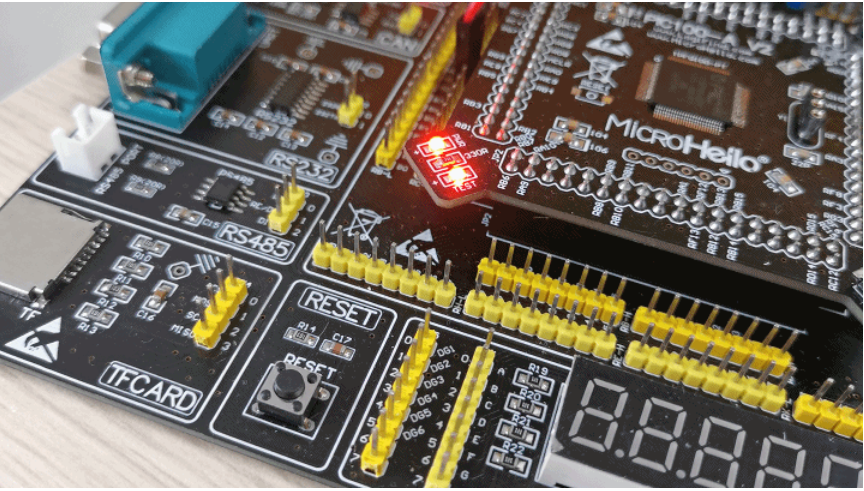1、使用Harmony配置内核定时器
1、在Available Components组件中将CORE TIMER添加到Project Graph中;

2、组件添加后,组件初始内容如下;

其中Enable Interrupt Mode是使能中断模式,勾选后会自动生成中断相关代码;
Stop Timer in Debug mode是在空闲模式下的操作,勾选后在空闲模式下停止模块;
Compare period(milliseconds)是比较周期,系统时间频率是4MHz;
Enable Interrupt Mode显示如下

3、点击Generate Code生成代码;
4、代码生成后需要的操作;
1、系统初始化完成后添加系统延时初始化函数;
2、添加应用层操作函数;
5、编译运行将代码烧录到开发板中;
2、实际代码分析
在plib_coretimer.c文件
static uint32_t compareValue = CORE_TIMER_COMPARE_VALUE;
//内核定时器初始化
void CORETIMER_Initialize()
{
// Clear Core Timer
_CP0_SET_COUNT(0);
_CP0_SET_COMPARE(compareValue);
// Enable Timer by clearing Disable Count (DC) bit
_CP0_SET_CAUSE(_CP0_GET_CAUSE() & (~_CP0_CAUSE_DC_MASK));
}
//内核定时器启动
void CORETIMER_Start( void )
{
// Disable Timer by setting Disable Count (DC) bit
_CP0_SET_CAUSE(_CP0_GET_CAUSE() | _CP0_CAUSE_DC_MASK);
// Clear Compare Timer Interrupt Flag
IFS0CLR=0x1;
// Clear Core Timer
_CP0_SET_COUNT(0);
_CP0_SET_COMPARE(compareValue);
// Enable Timer by clearing Disable Count (DC) bit
_CP0_SET_CAUSE(_CP0_GET_CAUSE() & (~_CP0_CAUSE_DC_MASK));
}
//内核定时器停止
void CORETIMER_Stop( void )
{
// Disable Timer by setting Disable Count (DC) bit
_CP0_SET_CAUSE(_CP0_GET_CAUSE() | _CP0_CAUSE_DC_MASK);
}
//获取内核定时器频率
uint32_t CORETIMER_FrequencyGet ( void )
{
return (CORE_TIMER_FREQUENCY);
}
//设置内核定时器频率
void CORETIMER_CompareSet ( uint32_t compare )
{
compareValue = compare;
_CP0_SET_COMPARE(compareValue);
}
//获取内核定时器计数值
uint32_t CORETIMER_CounterGet ( void )
{
uint32_t count;
count = _CP0_GET_COUNT();
return count;
}
//
bool CORETIMER_CompareHasExpired( void )
{
if (IFS0bits.CTIF != 0)
{
// Clear Compare Timer Interrupt Flag
IFS0CLR=0x1;
return true;
}
return false;
}
//内核定时器毫秒延时
void CORETIMER_DelayMs ( uint32_t delay_ms)
{
uint32_t startCount, endCount;
/* Calculate the end count for the given delay */
endCount=(CORE_TIMER_FREQUENCY/1000)*delay_ms;
startCount=_CP0_GET_COUNT();
while((_CP0_GET_COUNT()-startCount)<endCount);
}
//内核定时器微秒延时
void CORETIMER_DelayUs ( uint32_t delay_us)
{
uint32_t startCount, endCount;
/* Calculate the end count for the given delay */
endCount=(CORE_TIMER_FREQUENCY/1000000)*delay_us;
startCount=_CP0_GET_COUNT();
while((_CP0_GET_COUNT()-startCount)<endCount);
}
需要注意的点:毫秒延时函数以及微秒延时函数采用当前值减去起始值,再与需要计数的值进行比较,数值类型均为32位,因此长时间计数可能存在溢出的情况,该点需要注意。
3、实验验证
1、使用内核定时器毫秒延时函数,LED灯延时500ms翻转,编译完成后烧录到开发版中,LED灯闪烁。

————————————————
版权声明:本文为CSDN博主「Huangtop」的原创文章,遵循CC 4.0 BY-SA版权协议,转载请附上原文出处链接及本声明。
原文链接:https://blog.csdn.net/Huangtop/article/details/119791565
